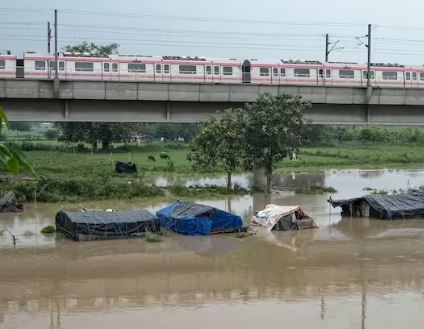New Delhi: The Yamuna river in Delhi swelled to the highest recorded level in 10 years Tuesday and is expected to rise further, officials said Tuesday.
According to the Central Water Commission’s (CWC) flood-monitoring portal, the water level at the Old Railway Bridge rose from 205.4 metres at 5 pm on Monday to 206.76 metres at 8 pm on Tuesday as Haryana discharged more water into the river from the Hathnikund barrage in Yamunanagar.
It is expected that the river will rise to 207 metres in the early hours on Wednesday and continue to rise further.
Delhi recorded a rapid increase in the Yamuna water level over the last two days. It shot up from 203.14 metres at 11 am on Sunday to 205.4 at 5 pm on Monday, breaching the danger mark of 205.33 metres 18 hours earlier than expected.
The river had exceeded the evacuation mark of 206 metres on Monday night, prompting the relocation of people residing in flood-prone areas to safer locations and a closure of the Old Railway Bridge for road and rail traffic.
“The Yamuna water level at the Old Railway Bridge rose to 206.76 metres by 8 pm, which is the highest since 2013 when the river reached a level of 207.32 metres,” a senior irrigation and flood control department official told PTI.
He explained that the sharp rise in water level was due to continuous rainfall in the upper catchment areas and saturated soil from heavy precipitation in Delhi and nearby regions over the weekend.
People living in low-lying areas have been shifted to safer places at higher altitudes, the department said on Tuesday evening.
It said 45 boats have been deployed for awareness, evacuation and rescue work and NGOs have been roped in to provide relief to the evacuated people.
“The Old Railway Bridge has been closed for traffic. All gates of the Okhla Barrage have been opened to release excess water and prevent prolonged high water levels,” the department said.
All district magistrates concerned and their sector committees are alert and are working in coordination with Irrigation and Flood Control Department, Delhi Police, Delhi Jal Board, Delhi Urban Shelter Improvement Board and other stakeholders to deal with the flood situation, it said.
With floodwaters entering the low-lying areas, videos of Yamuna Bazar residents wading through knee-deep water made their way to social media.
Addressing a press conference on Monday, Chief Minister Arvind Kejriwal said a flood-like situation is unlikely in Delhi, but the city government is prepared to tackle any eventuality. He had said the evacuation of people from low-lying areas will start once the river breaches the 206-metre mark.
An official from East Delhi district said the evacuation process began on Monday night after floodwaters entered some areas. “Only those living in the affected areas have been shifted to camps on higher grounds,” he said.
According to the CWC, the flow rate at the Hathnikund barrage increased to 3,59,760 cusecs at 11 am, the highest in the last three days.
Normally, the flow rate at the barrage is 352 cusecs, but heavy rainfall in the catchment areas increases the discharge. One cusec is equivalent to 28.32 litres per second.
The water from the barrage takes around two to three days to reach Delhi.
The India Meteorological Department said heavy rain pounded several places in Uttarakhand and Himachal Pradesh overnight, raising concerns about a further rise in the water level in rivers.
Large parts of Uttarakhand received more rain during the day.
The Delhi government issued a flood warning on Sunday. Authorities have been instructed to stay vigilant and take necessary action in vulnerable areas. Quick response teams and boats have also been deployed.
Sixteen control rooms have been set up to monitor the flood-prone areas and the water level of the Yamuna. More than 50 motorboats have been deployed for rescue-and-relief operations, and diving and medical teams have been readied with all the necessary materials and equipment.
Northwest India has seen incessant rainfall over three days from Saturday, with many areas in Jammu and Kashmir, Uttarakhand, Himachal Pradesh, Haryana, Uttar Pradesh and Rajasthan recording “heavy to extremely heavy” rains.
This has resulted in overflowing rivers, creeks and drains that have massively damaged infrastructure and disrupted essential services in Jammu and Kashmir, Himachal Pradesh, Uttarakhand and Punjab.
Delhi witnessed its highest rainfall (153 mm) in a single day in July since 1982 in the 24-hour period ending at 8:30 am on Sunday. The city received an additional 107 mm of rain in the subsequent 24 hours, exacerbating the situation. The heavy rain transformed roads into gushing streams, parks into watery labyrinths and marketplaces into submerged realms.
The Yamuna river system’s catchment covers parts of Uttar Pradesh, Uttarakhand, Himachal Pradesh, Haryana, Rajasthan, Madhya Pradesh and Delhi.
The low-lying areas near the river in Delhi, inhabited by around 41,000 people, are considered prone to flooding. Encroachments on the river floodplain have occurred over the years, despite the land belonging to the Delhi Development Authority, the revenue department and private individuals.
The Yamuna breached the danger mark twice in September last year, with the water level reaching 206.38 metres.
In 2019, the river witnessed a peak flow rate of 8.28 lakh cusecs on August 18-19 and the water level rose to 206.6 metres. In 2013, it reached a level of 207.32 metres. The river had swollen to an all-time record water level of 207.49 metres in 1978.
PTI
